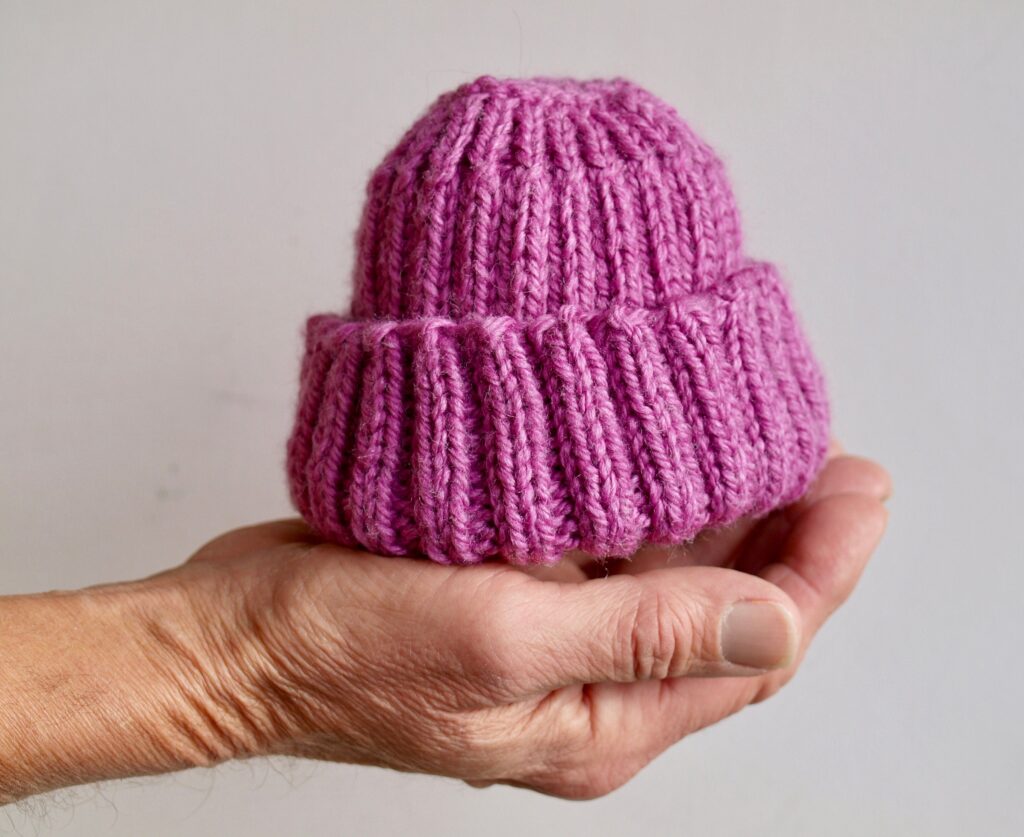This post was most recently updated on August 19th, 2022
 It’s deeply ingrained, this habit of putting hats on newborns. Search online for images of newborns and almost all of them are togged up in a woolly hat, for all the world like they are about to go outside for a snowball fight. So why do we do it? And why do so many midwives and doctors insist that babies’ heads are covered the minute they emerge from the wardrobe-less confines of the womb?
It’s deeply ingrained, this habit of putting hats on newborns. Search online for images of newborns and almost all of them are togged up in a woolly hat, for all the world like they are about to go outside for a snowball fight. So why do we do it? And why do so many midwives and doctors insist that babies’ heads are covered the minute they emerge from the wardrobe-less confines of the womb?
The answer I mostly get from midwives when I ask is that babies lose lots of heat from their heads and can get cold. This confuses me. I wonder why on earth evolution would have created such a faulty system for our species. So I did a bit of digging. It seems a myth sprang up in the 1970s that led to us all believing that humans lose most of their heat from their heads. Apparently, this myth has it’s origins in a military experiment from the 1950s, in which scientists measured heat loss in soliders in snowy conditions. Because the only part of their bodies uncovered were their heads, it’s hardly surprising that they found the majority of heat lost was from their head. Of course, if they hadn’t been wearing any pants, logic would tell us that they would have lost body heat through their nether regions….heads are not special heat radiators!
And yes, this old research has been debunked many times since then. And yet, when it comes to newborn babies, we still perpetuate this old wives tale. But why does it matter, I hear you ask? Well, I’ll hand over here to Birthkeeper and maternity campaigner, Kemi Johnson:
When we put a hat on the baby immediately post birth, we sabotage the oxytocin flow for the mother because she can’t smell that wet head and stroke it…causing contractions that’ll keep her uterus toned and thus prevent haemorrhage
Someone who has just given birth is in a parallel dimension. Birth is a foreign country; in those minutes after birth, she must travel back to this time and place and re-enter her own body. Parents need to ground themselves in the here and now after their epic quest, by touching, smelling and kissing the baby. Left to themselves, feeling unobserved, parents will lower their faces to that crown that only moments before stretched perineum and heart wide open, and drink their baby in. Watch carefully and you’ll notice it cause uterine contractions.
As a witness to many, many births over the last twenty years, I can relate to this so much. The ritualistic hatting of the baby is all too often the seed that disrupts a physiological birth of the placenta. Rather that remaining safe in their golden bubble of oxytocin immediately after the birth, the midwife asks if they have a hat for the baby, or grabs one knitted by a stranger and swoops in to cover that delicate little scalp. Sometimes there is fuss and noise as people search through suitcases for hats. The hats usually slip off the moment they are put on, so there is repeated fussing around the baby. It wakes the mother up, pulling her out of her dream-like oxytocin high which all too often leads to problems with the placenta being born.

Just a reminder: a newborn’s temperature is regulated by skin to skin contact. The mother’s or birthing parent’s chest is nature’s incubator; if the baby is too cold, blood will rush to the mother’s chest to warm the infant. The birthing environment is almost always toasty warm and if it isn’t, steps can be taken to warm the dyad. Skin to skin also regulates the baby’s heart rate and breathing and increases the chances of breastfeeding getting off to a flying start.
As Carla Hartley, birth activist, says, “No hatting, No patting, no chatting” in those fragile hours after birth. In other words, if all is well, leave the new family be and give them peace and space to greet their newborn.
Jacqui Tomkins is an independent midwife who is equally passionate about this delicate moment as me. Here she is passing on a fascinating fact about the chemical cocktail that a good sniff of that little bonse will provide:
Scientists have discovered an odorless scent molecule called hexadecanal, or HEX, that is released by humans and impacts aggressive behaviour. The HEX molecule is the most adundant molecule released on the newborn’s head. The researchers found that this molecule reduced aggression in males (biologically important as infanticide is a relatively common event in the mammalian world) and increased aggression in females (key to infant protection).
Source: Eva Mishor et al., Sniffing the human body volatile hexadecanal blocks aggression in men but triggers aggression in women, Science Advances (2021). DOI: 10.1126/sciadv.abg1530
How cool is that, eh? How often do we have to be reminded that we are the pinnacle of millions of years of natural selection? Mother Nature really has designed a pretty damn fine system, if only we can stop meddling for a minute! As Dr Sarah Buckley says,
“mothers’ body heat is sufficient to keep all mammalian babies warm though skin-to-skin contact!”
I’ll add another ripple effect of the hats thing here – the confusion it causes to parents. One minute, you’re on a postnatal ward that is hotter than the surface of the sun, being ordered to keep a hat on your newborn and wrapped up in blankets like a burrito. The next minute you’re at home, being told by a community midwife or health visitor to never put a hat on a baby indoors and being scared witless about overheating the baby. This kind of conflicting advice undermines parents’ confidence in their own parenting abilities and quite possibly erodes their faith in health professionals.
But back to haxadecanal – I’ll leave you with this thought: one definition of hex is to ‘cast a spell or bewitch’, so the baby, literally, hexes the parents! Another meaning of hex is to curse and I think the habit of hatting is just that – a jinx on those precious post birth moments.
Are you planning your birth and would like to have a conversation about more stuff like this with me? Contact me through my doula website
Dreaming of being about to support new parents navigating their options? Check out our doula training
And please do feel free to leave me a comment. Did you have a hat put on your baby? How did it feel?
Additional resource for the person below who would like more references in this post. I searched and searched for some actual evidence that term, healthy babies need hats when in skin to skin contact and couldn’t find any. This article from stanford university clearly states that even pre-term infants need to be kept warm in ways that does not involve hatting them. If anyone can find me some solid studies that prove that healthy term infants require hats in the first 24 hours of life, I’d love to see it, and will be happy to edit this piece to reflect said information.
Second additional resource for those interested in the traffic light hat scheme that seems to be being rolled out across the NHS. This article sums up my worries!
A member of my extended family birthed her baby last week on the HOTTEST day on record! The midwife put a thick woolly hat on the baby. When mum protested, she was told baby needed a blanket too! So frustrating that healthcare professionals are perpetuating this nonsense and undermining parents’ confidence.
Gosh that poor baby!
I wonder when it became mainstream, my 3 were born between 1995 and 2003, the first 2 in hospital, and there was no mention of putting hats on them then.
It just shows how things differ around the country. Both mine born around the same time and the hat was de rigour in my hospital 🙄
My first was born in a small hospital. Hats were not mentioned. Second two at home, again no hats came into the discussion. Late 1970s and 80s.
Where is your research for this? All I see are anecdotal quotations from non-medical professionals who have not studied for years about the anatomy of the newborn or the process of heat transfer or about the different chemicals and hormones released when a neonate is born? Sure, anecdotal stories are interesting but surely we need more evidence of research with this before we make sweeping false statements about how putting on a little hat ‘ sabotages’ (love the hyperbole) oxytocin release and thus influences uterine contractions and even haemorrhaging(?!). Goodness.
Thanks for your comment Jane. Kemi was a midwife for many, many years actually. Perhaps you’d like to look her up. Jacqui is the Chair of IMUK and an extremely experienced midwife. The reearch on ‘hex’ is clearly referenced in my piece.
I’ll chuck the ball back over the net to you. Can you provide us with solid evidence that babies need hats? Or solid evidence that hats DON’T impact the physiology of the immediate postpartum? I’d be fascinated to hear your thoughts and quick to add to this article if you can find me some research to debunk what I’ve written. Thanks so much. Maddie x
Lovely, thank you for this important reminder. I have also heard and (very unscientifically, I can’t remember where) that mothers and birthing people need and want to get their lips touching baby’s scalp in a brush of a kiss, while inhaling the hex. That kiss transfers biology to the mother’s/parent’s system so they start tailoring the needed protective factors in their milk-making glands – perfectly matched to their individual baby and location. Of course, the hat stops all that. Nature is unbelievably clever 🙂
Yes another really really good reason not to get in the way! I too learned that mothers ‘sample’ the pathogens on the baby by kissing and or licking the baby in order to create exactly the correct antibodies for the child in their milk.